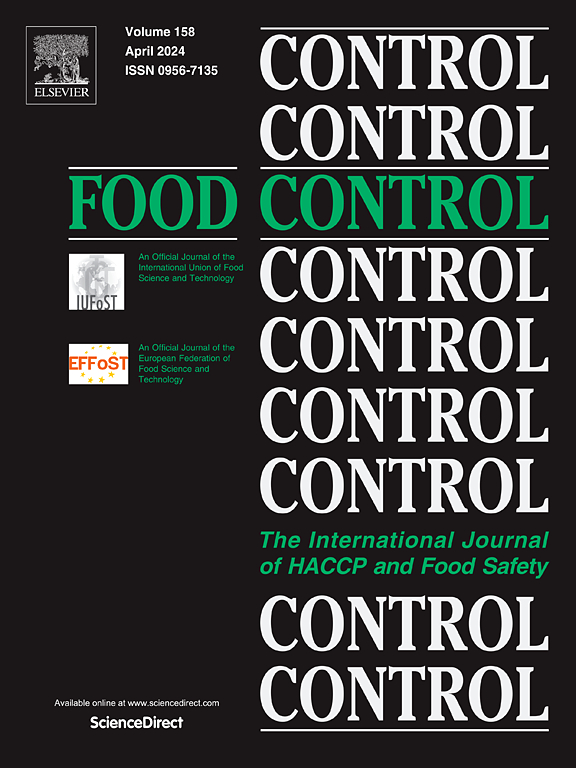Natural glycolipids as a surface treatment prevent fungal spoilage of fermented sausages during ripening
IF 6.3
1区 农林科学
Q1 FOOD SCIENCE & TECHNOLOGY
引用次数: 0
Abstract
Raw fermented sausages are susceptible to fungal contamination during their production, which involves fermentation and ripening in controlled environments. Commonly used preservatives, such as sorbate and natamycin, raise concerns regarding potential health impact and cross resistance development, respectively. This study investigated the efficacy of natural microbial glycolipids as surface treatment for controlling fungal growth on fermented sausages in fiber and collagen casings. A 0.1 % (w/v) glycolipid solution performed similarly to a solution of natamycin at the same concentration in terms of suppression of fungal counts in both types of casings. The addition of 2.5 % (v/v) lactic acid to the 0.1 % (w/v) glycolipids solution tended to further delay the development of fungal growth. Furthermore, glycolipids prevented the visible growth of any contaminants on the surface of the casings. In contrast, heavy growth was observed on natamycin treated and on untreated sausages. Metagenomic analysis of the casing surface microbiota showed no difference in the fungal profile between treatments but higher abundance of staphylococci on the natamycin treated casings compared to the glycolipid treated ones. Staphylococcus xylosus was identified as the dominant organism exclusively on natamycin treated sausages, probably stemming from the starter culture. These results suggest that natural glycolipids, especially in combination with lactic acid, are an alternative to natamycin for controlling surface microbial contamination during ripening of raw fermented sausages.
天然糖脂作为表面处理防止发酵香肠在成熟过程中的真菌变质
生发酵香肠在生产过程中容易受到真菌污染,这涉及到在受控环境中发酵和成熟。常用的防腐剂,如山梨酸酯和纳他霉素,分别引起了对潜在健康影响和交叉耐药性发展的关注。本研究考察了天然微生物糖脂作为表面处理对纤维和胶原肠衣发酵香肠真菌生长的控制效果。在两种类型的肠衣中,0.1% (w/v)的糖脂溶液与相同浓度的纳他霉素溶液在抑制真菌计数方面表现相似。在0.1% (w/v)的糖脂溶液中添加2.5% (v/v)的乳酸会进一步延缓真菌的生长发育。此外,糖脂阻止了任何污染物在肠衣表面的明显生长。相比之下,在纳他霉素处理和未处理的香肠上观察到大量生长。肠衣表面微生物群的宏基因组分析显示,不同处理之间的真菌谱没有差异,但纳他霉素处理的肠衣上的葡萄球菌丰度高于糖脂处理的肠衣。木葡萄球菌被鉴定为纳他霉素处理香肠的优势菌,可能源于发酵剂。这些结果表明,天然糖脂,特别是与乳酸结合,是纳他霉素的替代品,用于控制生发酵香肠成熟过程中的表面微生物污染。
本文章由计算机程序翻译,如有差异,请以英文原文为准。
求助全文
约1分钟内获得全文
求助全文
来源期刊

Food Control
工程技术-食品科技
CiteScore
12.20
自引率
6.70%
发文量
758
审稿时长
33 days
期刊介绍:
Food Control is an international journal that provides essential information for those involved in food safety and process control.
Food Control covers the below areas that relate to food process control or to food safety of human foods:
• Microbial food safety and antimicrobial systems
• Mycotoxins
• Hazard analysis, HACCP and food safety objectives
• Risk assessment, including microbial and chemical hazards
• Quality assurance
• Good manufacturing practices
• Food process systems design and control
• Food Packaging technology and materials in contact with foods
• Rapid methods of analysis and detection, including sensor technology
• Codes of practice, legislation and international harmonization
• Consumer issues
• Education, training and research needs.
The scope of Food Control is comprehensive and includes original research papers, authoritative reviews, short communications, comment articles that report on new developments in food control, and position papers.
 求助内容:
求助内容: 应助结果提醒方式:
应助结果提醒方式:


